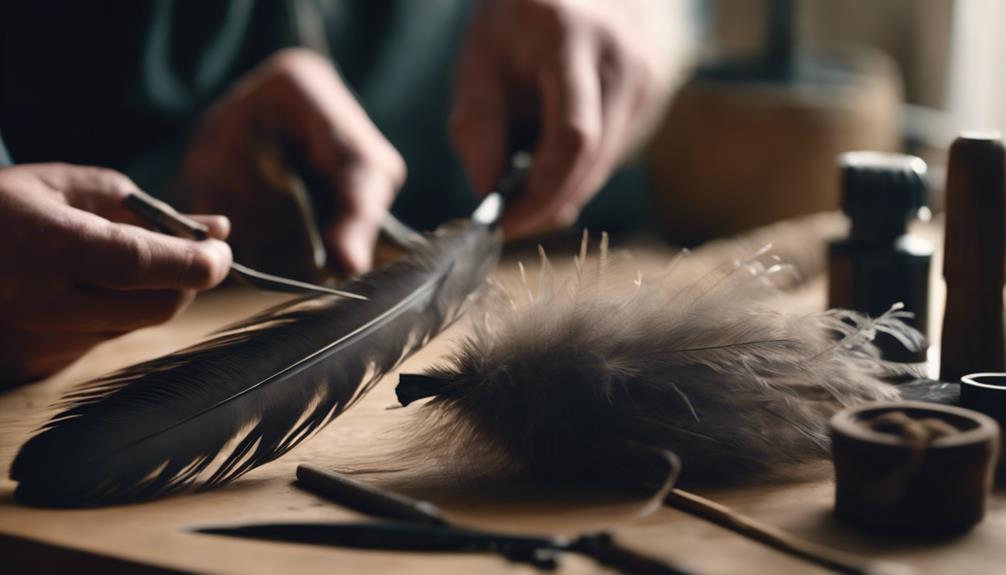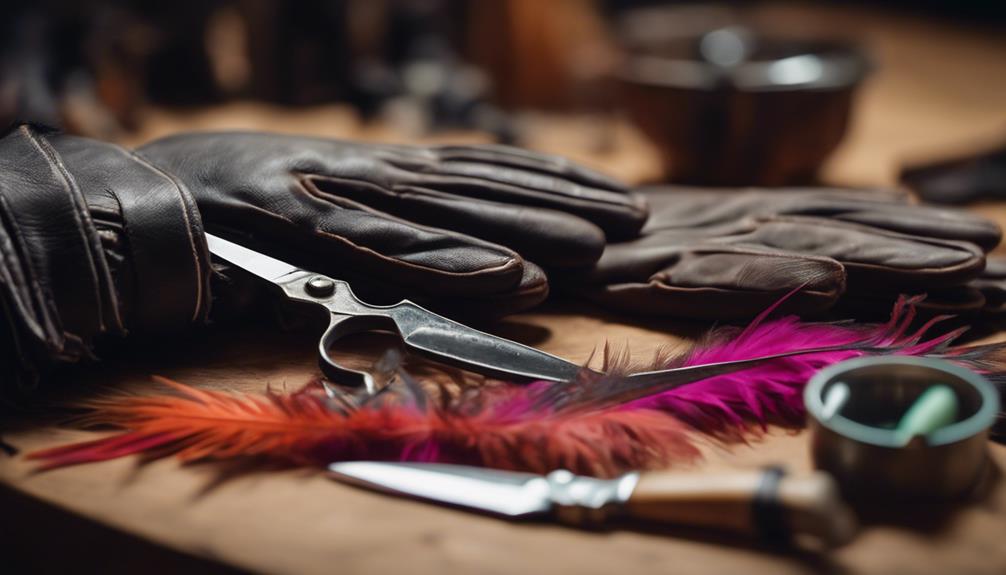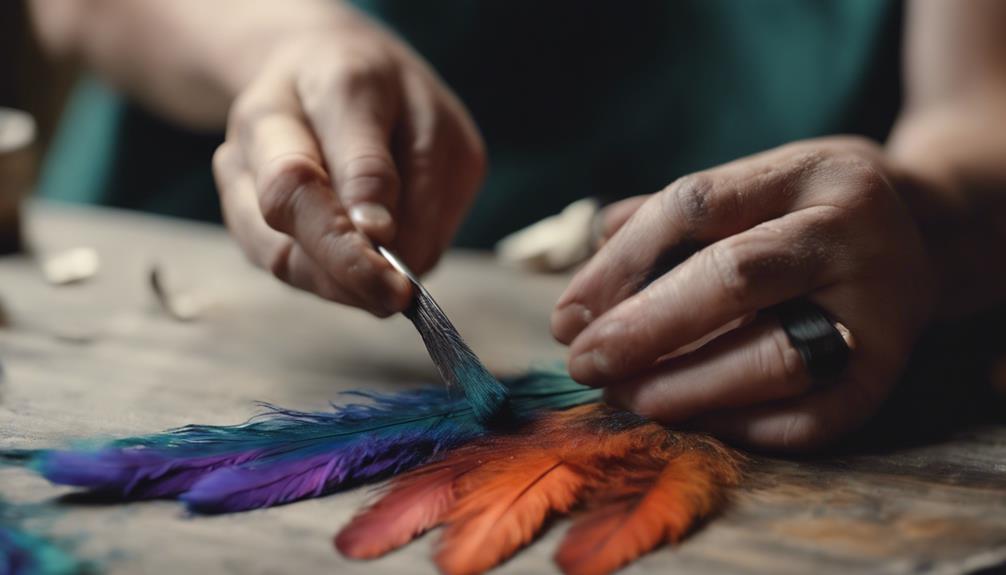
When it comes to collecting and processing emu feathers, precision is key. From the initial gathering to the final product, each step plays a crucial role in ensuring quality.
Ever wondered how these magnificent feathers are carefully plucked and transformed into various products? Let's explore the meticulous process and discover the intricate art behind handling emu feathers with utmost care and expertise.
Key Takeaways
- Sustainable harvesting methods ensure quality and ethical practices.
- Emphasize gentle plucking for intact, durable feathers.
- Proper cleaning, sanitizing, and drying techniques maintain feather quality.
- Quality assurance, precise processing, and marketing strategies are essential for superior products.
Emu Feather Collection Process

When gathering emu feathers, ensure to methodically pluck them from the bird's plumage without causing harm or distress. Sustainable harvesting practices are crucial to maintain the health and well-being of the emus. By carefully selecting which feathers to collect, you can ensure the highest quality for use in various products. Feather quality is imperative, as it determines the durability and appearance of the final goods.
To sustainably harvest emu feathers, start by gently restraining the bird to minimize stress. Then, using precise movements, pluck the feathers, taking care not to damage the follicles or skin. This meticulous process guarantees that the feathers remain intact and pristine, ready for further processing. By focusing on sustainable practices, you contribute to the preservation of emu populations and their natural habitats.
Emu Feathers: Properties and Characteristics
To understand the properties and characteristics of emu feathers, one must examine their unique structure and composition closely. Emu feathers exhibit fascinating traits that make them distinct from other types of feathers. Here are some key points to consider:
- Emu Feathers: Color Variations
- Emu feathers come in a wide range of colors, including shades of brown, black, and grey. The color variations can be attributed to the presence of different pigments within the feathers, giving them a dynamic and visually appealing appearance.
- Feather Care Techniques
- Proper care is essential to maintain the quality and longevity of emu feathers. Regular grooming and cleaning can help prevent dust and dirt accumulation, preserving the feathers' natural luster. Additionally, storing the feathers in a cool, dry place away from direct sunlight can prevent fading and deterioration over time.
- Structure and Composition
- Emu feathers are characterized by their strong and flexible shafts, which provide durability and resilience. The intricate arrangement of barbs and barbules allows for effective insulation and water resistance, making emu feathers well-suited for various applications in the fashion and craft industries.
Tools Needed for Feather Collection

Several essential tools are required for the efficient collection of emu feathers. To accurately identify different types of feathers, feather identification tools such as magnifying glasses, tweezers, and reference guides are necessary. These tools help you recognize the unique characteristics of emu feathers, distinguishing between down feathers and contour feathers, which is crucial for sorting during the collection process.
For optimal collection efficiency, you'll need specialized tools like gentle combs and brushes to gently remove feathers without causing damage. Additionally, having airtight containers or vacuum-sealed bags for storage is vital to preserve the feathers' quality and prevent contamination.
Proper storage is essential to maintain the feathers' integrity until further processing. Ensure the storage containers are labeled with the date and location of collection for tracking purposes. By utilizing the right tools for feather identification, efficient collection, and preservation, you can gather high-quality emu feathers effectively while ensuring their long-term quality.
Emu Feather Harvesting Guidelines
To effectively harvest emu feathers, it's crucial to follow specific guidelines that ensure the quality and integrity of the feathers during the collection process. Emu feather harvesting guidelines play a pivotal role in maintaining feather quality and upholding ethical sourcing practices.
- Gentle Plucking Technique: Emus should be gently restrained during the plucking process to minimize stress and ensure the feathers aren't damaged in the extraction process.
- Avoiding Overharvesting: It's imperative to adhere to sustainable harvesting practices to prevent overharvesting and ensure the long-term well-being of the emu population.
- Regular Health Checks: Conduct regular health checks on the emus to ensure they're in optimal condition for feather collection, promoting both ethical sourcing and high-quality feathers.
Sorting Emu Feathers by Size

When sorting emu feathers by size, categorize them based on their length and width to ensure uniformity in the final product. Feather sizing is crucial for pricing and quality control in the feather industry. Efficient sorting techniques play a key role in achieving consistency in the final product.
Here is a table illustrating the sorting process:
| Feather Size | Length (inches) | Width (inches) |
|---|---|---|
| Small | 4-6 | 0.1-0.3 |
| Medium | 6-8 | 0.3-0.5 |
| Large | 8-10 | 0.5-0.7 |
| Extra Large | 10-12 | 0.7-0.9 |
| Jumbo | 12+ | 0.9+ |
Cleaning and Sanitizing Feathers
After sorting emu feathers by size to ensure uniformity, the next crucial step is to meticulously clean and sanitize the feathers to meet industry standards. To achieve this, follow these steps:
- Cleaning: Begin by gently washing the feathers in a mild detergent solution to remove dirt, dust, and any contaminants. Rinse them thoroughly in lukewarm water to ensure all residues are gone.
- Sanitizing: Submerge the feathers in a sanitizing solution, such as a mixture of water and vinegar or a commercial feather sanitizing product. Allow the feathers to soak for the recommended time to eliminate bacteria and microbes effectively.
- Drying: After cleaning and sanitizing, lay the feathers flat on a clean towel to air dry. Avoid direct sunlight or high heat, as this can damage the delicate structure of the feathers.
Drying Methods for Emu Feathers

For optimal preservation of emu feathers' integrity, employ suitable drying techniques post-cleaning and sanitizing. After the cleaning and sanitizing process, it's crucial to focus on drying methods to maintain the quality of the feathers. Air drying is a recommended method that involves placing the feathers in a well-ventilated area away from direct sunlight and humidity. This allows the feathers to dry naturally while ensuring that no damage occurs due to excessive heat or moisture.
Alternatively, heat setting can be used for a faster drying process. This method involves using controlled heat sources to dry the feathers quickly without compromising their structure. It's essential to regulate the temperature carefully to prevent overheating, which can lead to brittleness and breakage in the feathers.
Whether you opt for air drying or heat setting, the key is to monitor the process closely to prevent any damage to the delicate emu feathers. By following these drying methods, you can ensure that the feathers are preserved in optimal condition for further processing.
Emu Feather Processing Techniques
To enhance the quality and usability of emu feathers, mastering effective processing techniques is essential after ensuring proper drying methods have been employed. When it comes to processing emu feathers, attention to detail is key. Here are some crucial steps to consider:
- Feather Dyeing Techniques:
- Selecting high-quality, non-toxic dyes that are gentle on the feathers.
- Immersing the feathers evenly to achieve consistent coloration.
- Following precise dyeing times and temperature controls to prevent damage.
- Feather Product Innovations:
- Exploring new ways to utilize emu feathers in fashion, art, and crafts.
- Developing techniques to blend emu feathers with other materials for unique textures.
- Keeping abreast of industry trends to create innovative feather products.
Coloring Emu Feathers

Coloring emu feathers requires meticulous attention to detail in selecting suitable dyes and ensuring even immersion for consistent coloration. Feather dyeing techniques play a crucial role in achieving vibrant and long-lasting colors. The process involves carefully preparing the dye solution to the correct concentration and temperature, followed by immersing the feathers evenly to avoid patchy coloring.
To create unique feather color combinations, experiment with different dye mixtures and application methods. Consider blending primary colors to achieve custom shades or using techniques like ombre or dip-dyeing for gradient effects. It's essential to document the dyeing process meticulously, noting the dye concentrations, immersion times, and any additional treatments applied to the feathers.
Maintaining a clean and organized workspace is key to successful feather coloring. Ensure proper ventilation to prevent inhaling fumes from the dyes. By following precise dyeing techniques and exploring various color combinations, you can enhance the beauty and versatility of emu feathers for a wide range of creative projects.
Emu Feather Quality Assurance
Ensuring the quality of emu feathers involves conducting meticulous inspections and adhering to strict standards throughout the collection and processing stages. Feather grading is a critical aspect of quality assurance, where feathers are sorted based on their size, color, strength, and overall condition. This process ensures that only the highest quality feathers are selected for further processing, guaranteeing a superior end product for consumers.
Feather sterilization is another essential step in maintaining quality. Emu feathers are sterilized using specialized techniques to eliminate any potential contaminants or pathogens, ensuring that the feathers are safe for use in various applications. This sterilization process not only enhances the quality of the feathers but also prolongs their shelf life.
In addition to grading and sterilization, quality assurance also involves regular inspections at various stages of the collection and processing process. These inspections help identify any issues early on, allowing for corrective actions to be taken promptly, thus maintaining the overall quality of the emu feathers.
Packaging and Storage of Emu Feathers

In the packaging and storage of emu feathers, meticulous care and adherence to specific environmental conditions are essential to maintain their quality and integrity. Feather packaging and handling require attention to detail to prevent damage and ensure feathers remain pristine.
When packaging emu feathers, use breathable materials to prevent moisture buildup and potential mold growth. Handle the feathers delicately to avoid bending or breaking the delicate structure.
Storage solutions for feathers should include a cool, dry, and well-ventilated area to prevent degradation. Consider storing them in clean, airtight containers to protect against pests and dust. Avoid exposing the feathers to direct sunlight or extreme temperatures, as this can cause discoloration and brittleness.
Marketing Emu Feathers Products
To effectively market emu feathers products, understanding the target market's preferences and needs is crucial for successful promotion and sales. When diving into the world of feather fashion, staying abreast of market trends is essential. Here's how you can excel in marketing emu feathers products:
- Stay Trendy: Keep an eye on the latest feather fashion trends to align your product offerings with what's in demand.
- Promote Sustainability: Highlight your sustainable feather sourcing practices to appeal to environmentally conscious consumers. Educating customers about the ethical and eco-friendly aspects of your products can set you apart in the market.
- Customer Education: Provide detailed information about the benefits and unique qualities of emu feathers. Educating your customers about the properties of emu feathers can help them make informed purchasing decisions, fostering trust and loyalty.
Frequently Asked Questions
Can Emu Feathers Be Used for Any Other Purposes Besides Crafts and Decorations?
Emu feathers can also be utilized for clothing beyond crafts and decorations. Emu feather clothing combines beauty and functionality, providing warmth and style. Emu feather jewelry showcases the elegance and versatility of these feathers in intricate designs.
How Long Do Emu Feathers Typically Last Before They Start to Degrade?
Feathers of emus, sturdy yet delicate, can endure for years with proper care. Through feather preservation techniques, their longevity can be extended. However, without intervention, degradation may begin after several years, leading to natural deterioration.
Are There Any Regulations or Restrictions on the Collection of Emu Feathers?
When sourcing emu feathers, consider regulations and restrictions for conservation. Ensure feather quality by adhering to sustainable practices. Check local laws for collection guidelines. Respect wildlife and habitats to maintain balance and protect these valuable resources.
What Are Some Common Mistakes to Avoid When Collecting Emu Feathers?
When collecting emu feathers, avoid mishandling delicate tips that can break easily. Store them in a dry, cool place to prevent mold growth. Clean feathers gently with mild soap and warm water, avoiding harsh chemicals.
Are There Any Special Considerations to Keep in Mind When Working With Emu Feathers in Humid or Wet Environments?
In humid or wet environments, feather maintenance is crucial. Ensure proper drying techniques to prevent mold and damage. Hang feathers in a well-ventilated area, away from direct sunlight. Gently fluff and air dry to maintain quality.
Conclusion
As you carefully collect and process emu feathers, you unlock the beauty and versatility of these natural treasures. With the right tools and techniques, you can sort, color, and package these feathers to create stunning products.
By following harvesting guidelines and ensuring quality assurance, you guarantee a premium end result. Embrace the meticulous process of working with emu feathers, and witness the transformation from raw material to exquisite creations.




